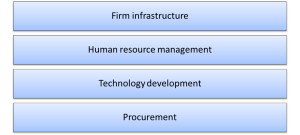Creating value for customers is a fundamental aspect in marketing success. To aid the process of value creation, Michael Porter developed tool for finding new ways to create customer value, which he refers to as the “the value chain”.
Nine components of Porter’s Value Chain
Porter’s value chain focuses on nine strategic activities that can create value (by providing more, or a lower cost) in an organization. He has categorized these nine activities into two groups: five primary activities and for support activities.
Note: Please see this article on how to use Porter’s Value Chain.
Primary activities
Primary activities are those functions that directly involve the production, transport, sale and follow-up of a product – from original supply components all the way to consumption and usage of the product.

Porter has defined the primary activities company as:
Inbound logistics: the activities regarding the receipt, the storage and dissemination of goods and materials necessary for the company’s activity;
Operations: the activity of converting the goods and materials into final products;
Outbound logistics: the activity of storing, transporting and distributing the final product to its customers;
Marketing and sales: the activities related to informing the customers about the company’s products or services, convincing potential buyers to purchase them and facilitating the buying process;
Service: the activities required for the product or service to work properly after the sale has been finalized.
Support activities
Support activities are functions that are necessary for the firm to operate, that do not directly contribute to the production, supply or sale of the product.
Porter’s list of support activities are:
Procurement: the activities related to the procurement of goods and materials necessary for the company’s activity.
Technological Development: the technical knowledge, the equipment, the hardware and the software that a company uses in order to convert materials into the final products;
Human resources management: the activities regarding the recruitment, the training, the development and the dismissal of the company’s employees;
Firm infrastructure: it includes the costs of general management, planning, accounting, finance and legal activities.

